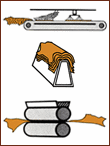|
|
 |
|
| Home |  | PROCESS OF TANNING | |
|
|
|
|
Process of Tanning
WHAT IS TANNING?
Leather is made from animal skins or hides which have been chemically treated to preserve quality and natural beauty. The chemical procedure used to ready raw animal hides for use is called "tanning." A piece of hide or skin which has been tanned produces a strong, flexible leather which is able to resist decay and spoilage.
The tanning process consists in strengthening the protein structure of the putrescible skin by creating a bond between the peptide chains. The skin is made up of three layers being the epidermis, dermis and subcutaneous layers. The dermis consists between 30-35% protein, which is mostly collagen, with the remainder being fat and water. It is the dermis that is used to make the leather after the other layers have been removed chemically or mechanically. The whole tanning process using acids, alkalis, salts, enzymes and tanning agents to dissolve the fats and non-fibrous proteins, as well as chemically bond the collagen fibres. The tanning process also produces a lot of waste which has now become an environmental concern.
The generic tanning process involves several steps, depending on the type of skin used and its desired end product:
 |
|
|
1. Warehousing and sorting
In the raw material area the skins are preserved in salt, stored in controlled cool rooms and before processing, presorted for quality and weight. |
| |
 |
|
2. Soaking
The skin is soaked to remove dirt and salt. |
|
| |
 |
3. De-Fleshing
During this process tissue, flesh and fat remnants are removed by a roller mounted knife
4. Liming
By adding lime and sulphur compound the hair is removed from the skin. |
 |
|
|
5. Bating, pickling, tanning
During bating and pickling the skins are treated with acid and salt in preparation for tanning.
During tanning the skin fibres absorb the tanning agents. That's when the skin becomes leather. |
| |
 |
|
6. Samming
During this process water is removed |
| |
 |
7. Splitting
In order to achieve an even specified thickness the leather is reduced in substance.
The resulting split-leather can than be processed further as suede. |
 |
|
8. Skiving
The grain leather is brought to an even thickness. |
| Irregularities are removed from the reverse side and the leather is separated into colour-batches. | |
| |
 |
|
|
9. Sorting
The leather is sorted into various quality grades. |
| |
 |
|
|
10. Neutralising, filling out, dyeing and greasing
The acid resulting from the tanning process is neutralized. Dyeing than takes place, where appropriate with anilin-dye-stuffs.
The greasing procedure will finally achieve the correct softness. |
| |
 |
11. Drying
Two methods are used to dry leather. The vacuum process during which moisture is removed by suction and the hanging process, when leather is hung and taken through ovens.
|
|
 |
|
12. Staking
Following drying the leather is mechanically staked in order to soften it. Further processes take place in preparation for finishing. |
| |
 |
|
13. Finishing
Here the leather is given its final surface treatment and look. Through processes of base coat, colouring, embossing, ironing the leather becomes, depending on the demands of fashion, matt or shiny, two-tone or uni-coloured, smooth or grained. The art of finishing lies in working in wafer-thin layers without disturbing the natural look of the leather and its characteristics such as suppleness and breathability. |
| |
 |
|
14. Quality Control
In between every process quality is controlled. |
| Final control checks to ensure each individual production is to specification and sortation into various trades. | |
 |
15. Despatch
The leather is measured electronically, wrapped and despatched.
|
|
|
|
|
|
All Trends Pte. Ltd.
50 Kallang Pudding Road, #07-05 Golden Wheel Industrial Building, Singapore 349326
Fax: +65 68440463
|
|
|
|
|
|
|
|
|



